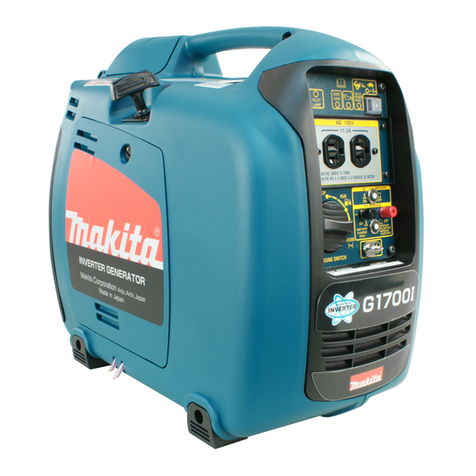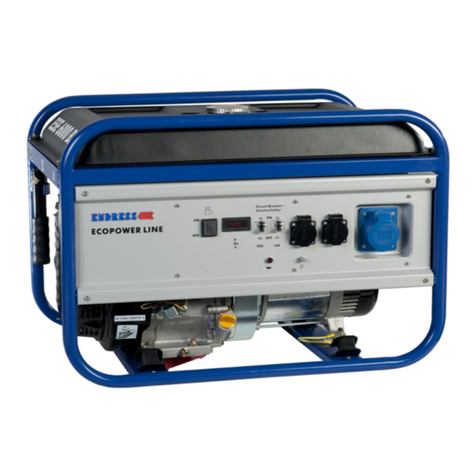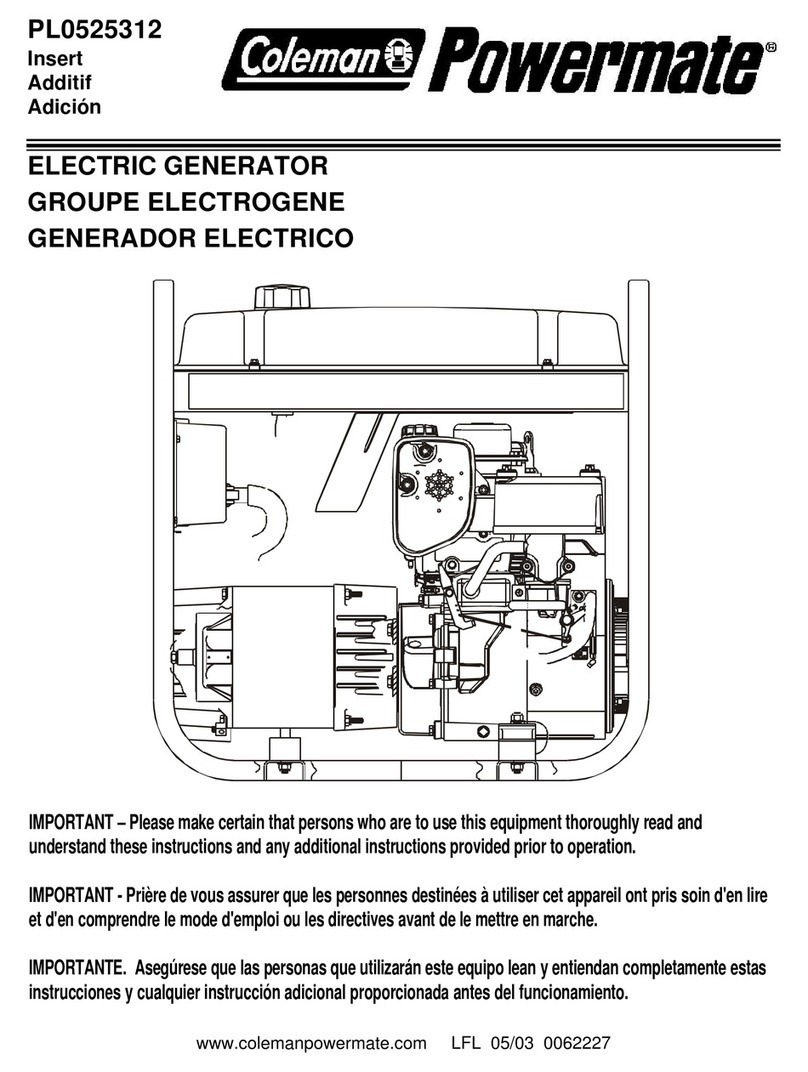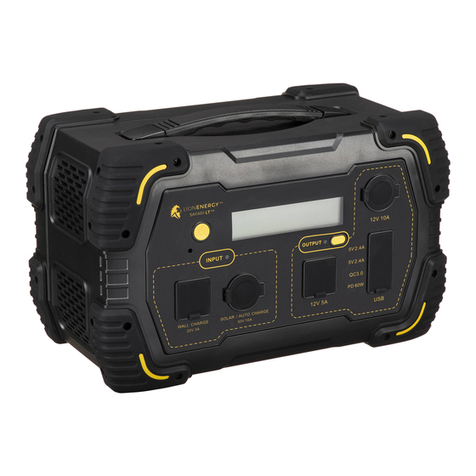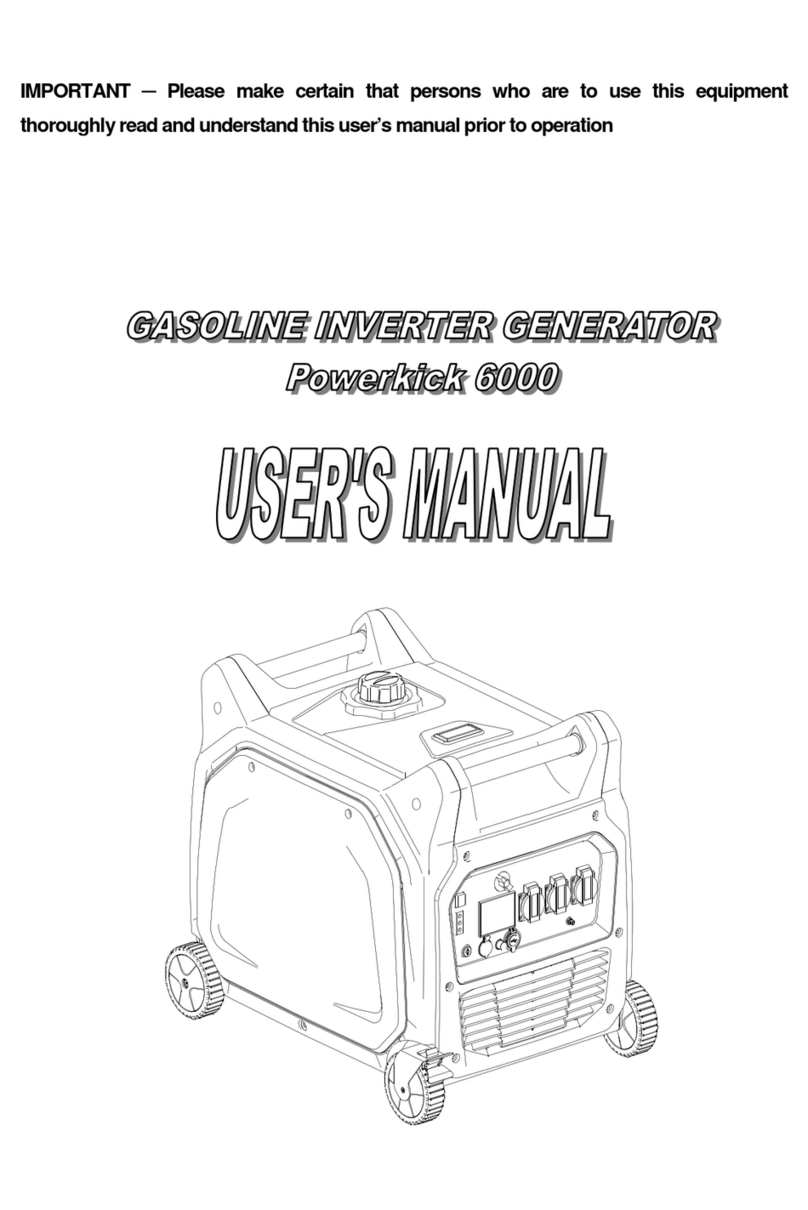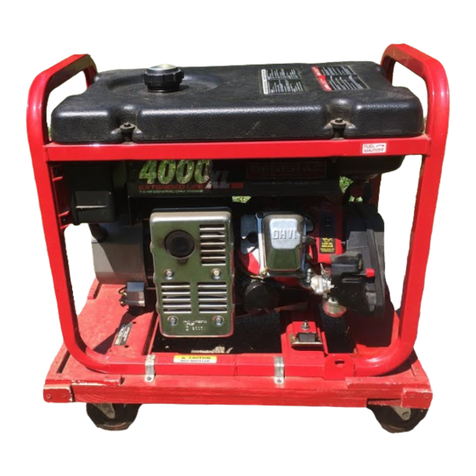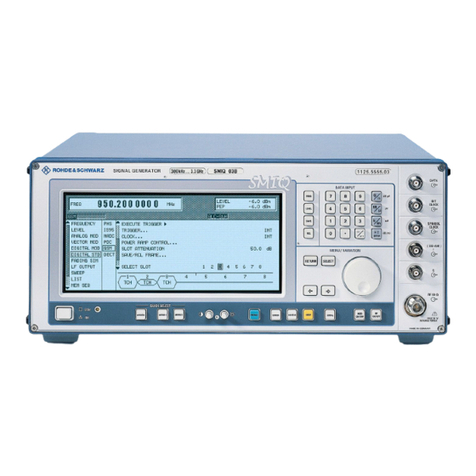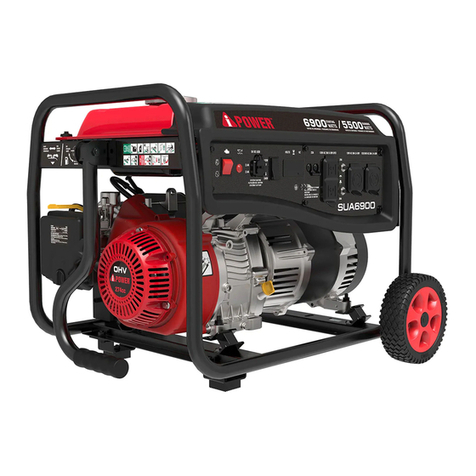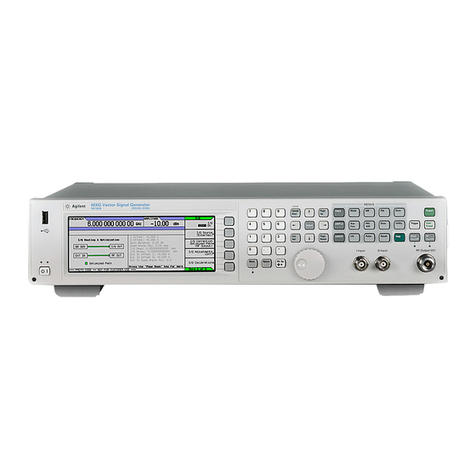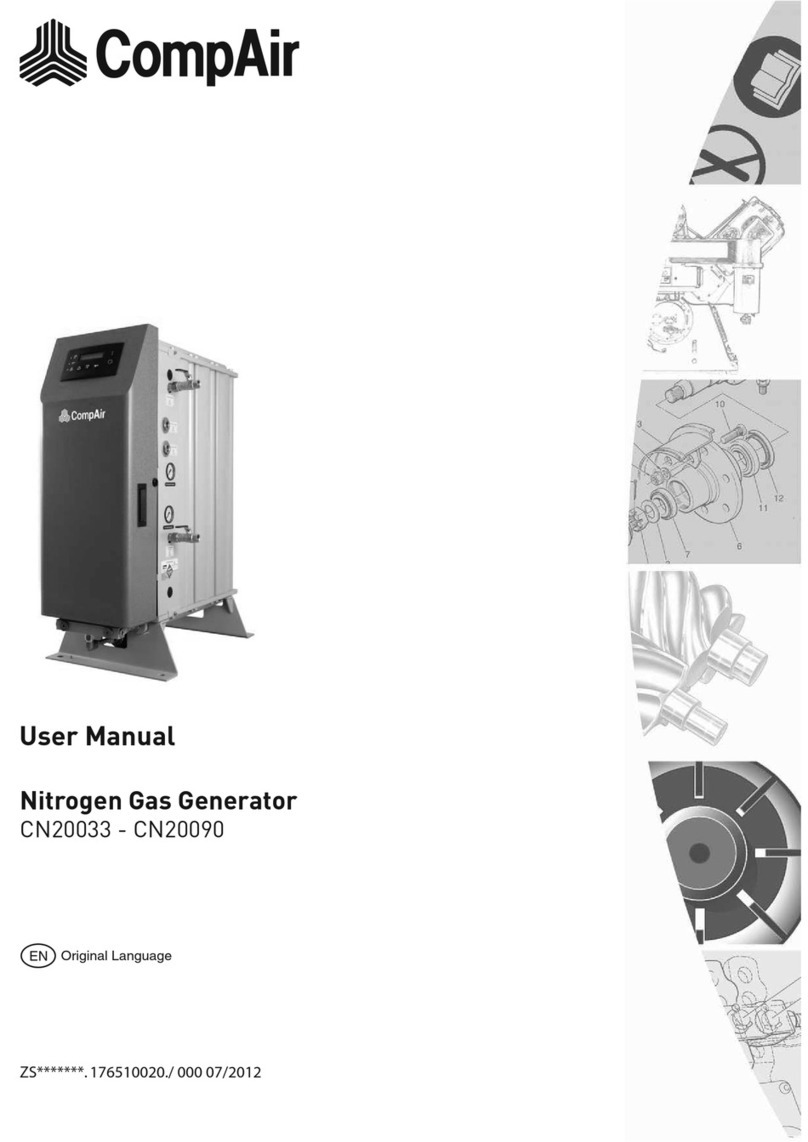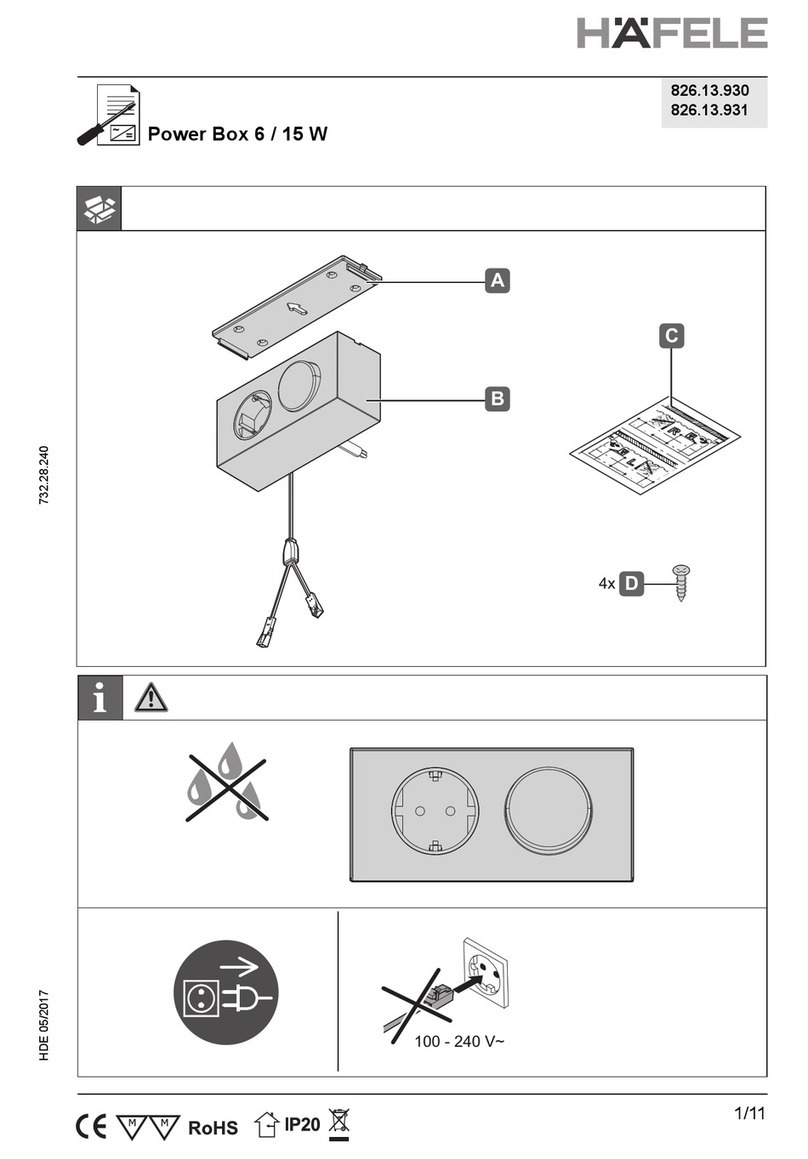Gillette Generators SP-200 User manual

INSTALLATION
GUIDE
FOR DRY FUEL MODELS:
(GM DRIVEN, DRY FUEL GEN-SETS)
SP-200
SP-250
SP-300
SP-410
SP-520
SP-620
SP-8005N
SP-960
SP-1200
SP-1500
GILLETTE GENERATORS
AUTOMATIC POWER SYSTEMS
OGU06-OWN795-20131219

PAGE 2
TABLE OF CONTENTS
Page
Introduction, General Cautions,Warnings, Danger & Danger Points -------3-10
Receiving, Un-packing and Installation of your Generator Set ---------------11-14
Muffler Installation on Open (No Housing) Gen-Sets ---------------------------14-16
Engine Radiator Systems --------------------------------------------------------------16-17
Starting, Battery Requirements -------------------------------------------------------17
Engine Oil Requirements and Generator Housing Information---------------18-19
Gaseous Dry Fuel Pipe Sizing Instructions ----------------------------------------19-21
Gaseous Dry Fuel System: Natural Gas---------------------------------------------21-22
Gaseous Dry Fuel System: Liquid Propane Vapor Gas (LPV) ------------------22-23
12 VDC Starting Battery Installation-------------------------------------------------24-25
Engine Oil and Engine Radiator Service-------------------------------------------25-26
Automatic Transfer Switch (ATS)-----------------------------------------------------26-27
Engine Spark Plug Service ------------------------------------------------------------27
Terminal Connector Torque Tightening Information ----------------------------28
Electrical/Mechanical Formulas That May Be Useful ----------------------------29
See separate Engine, Generator, or Optional Equipment manuals for more
specific operating details.
See separate Controller manual for actual operating details.

PAGE 3
PRODUCT SAFETY INFORMATION
SECTION 1
SAFETY RESPONSIBILITY
Be sure that you are completely familiar with the
safe operation of this equipment. Improper use
can cause serious or fatal injury.
GILLETTE Generator installation and repair
procedures require specialized skills. Contact
GILLETTE service department for repairs or any
questions you may have about the safe installation
and operation of this system.
The precaution statements are general guidelines
for the safe use and operation of this generator. It is
not practical to list all unsafe conditions. Therefore, if
you use a procedure that is not recommended or not
mentioned in this manual, you must determine if it is
safe for the operator and all personnel. If there is any
question of safety, please contact GILLETTE before
attempting installations or repairs. This generator
contains high voltages. Electrical shock can cause
serious or fatal injury. Only qualified personnel
should attempt the start-up procedure or repair of
this generator.
●Only qualified personnel with knowledge of the
safe installation, operation, and maintenance of this
generator should attempt installation, start-up,
operating, or repair procedures.
●Keep all non-qualified personnel at a safe distance
from this generator.
●Always stop generator and allow generator cool-
down before refueling, restoring oil level, or adding
to radiator coolant.
●Always stop generator before making or removing
any connections.
RESPONSIBILITY
When your generator is delivered, it becomes the
responsibility of the owner and installer to prevent
unsafe installation conditions and operation of the
generator. Some responsibilities include (but are not
limited to) the following:
●It is the responsibility of the owner/operator of this
generator to ensure that this generator is correctly
installed.
●It is the responsibility of the owner of this
generator to ensure that any person operating this
generator has access to all GILLETTE manuals and
information required for the safe use and operation of
this generator.
●It is the responsibility of the owner of this
generator to ensure that any person operating this
generator has been properly trained.
●It is the responsibility of the owner of this
generator to ensure that it is properly maintained at
regular service periods.
●It is the responsibility of the owner/operator of this
generator to ensure that this installed generator fully
complies with all federal, state, and local codes.
READ THIS MANUAL THOROUGHLY AND
KEEP A COPY AT GENERATOR SITE
If you do not understand any procedure, precaution
or any safety warning statement, or any part of this
manual, contact GILLETTE or your nearest GILLETTE
representative.
IMPORTANT SAFETY INSTRUCTIONS
Precaution Statements Used In This Manual
There are four classifications of precautionary
statements used in this manual. The most critical is a
“DANGER” statement, then the “WARNING”
statement, followed by “CAUTION”, and the least
critical is the “NOTICE” statement. The usage of
each statement is as follows:
DANGER: Indicates a potentially hazardous situation
which, if not avoided, could result in personal injury
or death.
WARNING: Indicates a potentially hazardous
situation which, if not avoided, could result in serious
personal injury.
CAUTION: Indicates a hazard that if not avoided,
might result in minor or moderate personal injury or
damage to gen-set.
NOTICE: Indicates technical or general information.
IMPORTANT SAFETY INSTRUCTIONS
SAVE THESE INSTRUCTIONS
This manual contains important instructions for the
generator that must be followed during installation,
operation, and maintenance of the generator, battery
(batteries), and fuel components. For ease of
reading, the following precautionary statements are
summarized in the next 3 pages and are specifically
mentioned again in some operation/installation
paragraphs, within this manual.
DANGER: Be sure that you are completely familiar
with the safe operation of this equipment. Improper

PAGE 4
use by non-qualified operator can cause serious or
fatal injury.
DANGER: Disconnect all electrical wires and load
devices from generator power outlets before
servicing the generator. Electrical shock can cause
serious or fatal injury.
DANGER: Be sure all wiring complies with the
National Electrical Code (NEC), Underwriters
Laboratories (UL), and all regional and local codes.
Improper wiring may cause a hazardous condition
and exposure to electrical hazards can cause serious
injury or death.
DANGER: Have electrical circuits and wiring
installed and checked by licensed electrician or
qualified technician. Electrical shock can cause
serious or fatal injury.
DANGER: Inspect all wiring frequently and replace
any damaged, broken, frayed wiring or wires with
damaged insulation immediately. Electrical shock
can cause serious or fatal injury.
DANGER: Never connect this generator to the
electrical system of any building unless a licensed
electrician has installed an approved automatic
transfer switch. The National Electrical Code (NEC)
requires that connection of a generator to any
electrical circuit normally powered by means of an
electric utility must be connected by means of an
approved automatic transfer switch equipment to
isolate the electrical circuit from the utility
distribution system when the generator is operating.
Failure to isolate the electrical circuits by using an
automatic transfer switch may result in injury or
death to utility power workers due to back-feed of
electrical energy onto the utility lines.
DANGER: Be sure the system is properly grounded
before applying power. Do not apply AC power
before you ensure that grounds are connected.
Electrical shock can cause serious or fatal injury.
NEC requires that the frame, the generator housing,
and exposed conductive surfaces (metal parts) be
connected to an approved earth ground. Local codes
may also require proper grounding of generator
systems.
DANGER: High voltage may be present whenever
engine is running. Electrical shock can cause serious
or fatal injury. Never operate electrical equipment
while safety screens and guards are removed, or
while standing in water, on wet ground or with wet
hands, feet or shoes, or while barefoot.
DANGER: Make sure protective covers over all
rotating parts such as drive shaft, pulley, belt, etc.
are in place. Rotating parts can cause extremely
dangerous situations because they can catch loose
clothing or extremities and cause serious of fatal
injury.
DANGER: Do not put hands, feet, tools, clothing, or
other objects near rotating parts such as cooling fan,
drive shaft, pulley, belt, etc. Rotating parts can snag
loose clothing or extremities and cause serious or
fatal injury.
DANGER: Disconnect the battery’s ground terminal
before working in the vicinity of the battery or
battery wires. Remove all rings, watches, necklaces,
or any jewelry before working on batteries. Contact
with the battery can result in electrical shock when a
tool or other metal object accidently touches the
positive battery terminal or wire. The risk of electric
shock is reduced when the battery ground lead is
removed during installation and maintenance.
DANGER: The positive battery cable is installed and
controlled in such a manner that if accidently cut or
sheared, the cable can not short out to the housing
doors. DO NOT remove any ground jumper installed
on generator set.
DANGER: The battery electrolyte is a dilute sulfuric
acid that is harmful to the skin and eyes. It is
electrically conductive and corrosive. The following
precautions are to be followed when working on
batteries: Wear protective clothing, safety glasses
and gloves; for eye contamination, flush eyes with
water and seek medical attention immediately; use
an acid neutralizer for spilled electrolyte. Remove all
jewelry (watches, rings, necklaces, etc.) and use
insulated tools when working with batteries.
DANGER: Engine coolant is under pressure and is
near boiling point of water when engine is hot. DO
NOT open the coolant system until the engine has
completely cooled. Hot coolant can cause severe
burns and other injuries. When engine is cool
(approximately one hour cooling time), coolant level
can be checked by slowly removing the turn-lock
radiator cap.
DANGER: Only a professional experienced
technician should install a fuel supply system. All
fuels are flammable and can cause fire, explosions,
injury, or death. Read and comply with special fuel
installations methods within this manual. Comply
with all NFPA regulations and local codes for shut-off
valves, regulators, fuel line type, connectors, etc.
DANGER: Exhaust fumes/gases are extremely
dangerous and can cause severe illness or death.
Never breath engine exhaust fumes. Only run the
engine outdoors where ventilation is plentiful, or
inside a non-inhabited room/building having specific
exhaust rules. Exhaust gases contain carbon
monoxide, a colorless, odorless, and extremely
dangerous gas that can cause unconsciousness or

PAGE 5
death. Symptoms of carbon monoxide poising
include: dizziness, nausea, headaches, sleepiness,
vomiting, or incoherence. If anyone experiences
these symptoms, get out into fresh air immediately.
Stop the engine and do not restart the engine until it
has been inspected and if necessary repaired or
generator may need an increase in cooling air input
and hot air output.
DANGER: Never operate the generator set indoors
in a poorly or non-ventilated area. Exhaust fumes are
extremely dangerous to all personnel and livestock
that are in a badly ventilated area.
DANGER: Before cleaning, inspecting, repairing, or
performing any maintenance to the generator set,
always be sure the engine has stopped and that all
rotating parts have also stopped. After stopping,
certain components are still extremely hot, so be
careful not to get burned. Before servicing the
generator set, be sure to disconnect the battery
terminals to prevent accidental engine rotation or
starting.
DANGER: Some parts of this generator rotate during
operation. Even though safety screens are installed
to protect operator and service personnel from
accidental contact, it is wise to know and understand,
that rotating parts are dangerous. Never touch any
part of generator until it is completely stopped
moving, then disconnect positive cable on battery.
DANGER: Never operate the engine when the air
cleaner is removed. This removal may cause a
backfire and serious burns can result.
DANGER: Do not smoke within 20 feet of generator
during standstill or operation, or within same
distance of fuel source. Fuels, and fuel fumes, can
cause fire, explosions, injury, or death.
DANGER: Check all fuel supply piping and their
connection monthly for leaks. All fuels are
flammable and can cause fire, explosions, injury, or
death.
DANGER: Incorrect installation of this generator set
and its fuel system could result in property damage,
injury, or death. Connection of the generator to its
fuel source must be done by a qualified professional
technician or contractor.
DANGER: Never allow the un-informed, children, or
animals to be in the area where the generator is
running. The generator, or the equipment being
powered by the generator, may cause illness, injury,
or death.
DANGER: Do not dispose of battery or batteries in a
fire, or mutilate the battery. The battery is capable of
exploding. If the battery explodes, electrolyte
solution is caustic and can cause sever burns and
blindness. If electrolyte contacts skin or eyes,
immediately flush the area with water and seek
medical attention quickly.
WARNING: Never permit anyone to operate the
generator without proper instructions. Be sure to
keep a copy of this manual with the generator so that
all users can read these precautions and be properly
informed of its safe operation.
WARNING: Never operate this generator in a
manner other than as described in this manual.
Operation in any manner not described in this
manual should be considered unsafe and should not
be attempted. Never start the engine unless you first
have verified that the installation and operation of the
generator is as described in this manual.
WARNING: When operating this generator keep
alert. Never operate machinery when physically or
mentally fatigued, or while under the influence of
alcohol, drugs, or medication.
WARNING: Always wear safety glasses and hearing
protection when working near the running generator.
WARNING: Never operate the generator unless all
guards, covers, shields, and other safety items are
properly installed.
WARNING: Positive and negative battery cables
should be insulated from “touch” (use battery
connection boots) on all battery connections.
WARNING: Installation and servicing of batteries is
to be performed or supervised by personnel
knowledgeable of batteries and the required
precautions. Keep unauthorized personnel away
from batteries.
WARNING: Keep a fire extinguisher near the
generator while generator is in use, and know how to
use the extinguisher. Use an extinguisher rated
“ABC” by the National Fire Protection Association.
WARNING: Installation and repair procedures
requires specialized skills with electrical generating
equipment. Any person that installs or performs
repairs must have these specialized skills to ensure
that the generator set is safe to operate. Contact
GILLETTE for installation or repairs, when questions
arise.
WARNING: Never connect or disconnect loads
during operation. Always connect load circuits
before starting the engine.
WARNING: Circuit overload protection (automatic
circuit breakers) must be provided in accordance

PAGE 6
with the National Electrical Code and local
regulations.
WARNING: Parts of this generator are extremely hot
during and after operation. To prevent severe burns,
do not touch any part of the generator until you have
first determined it has cooled down to a safe point to
touch.
WARNING: Be sure that you understand how to stop
the engine quickly in case of an emergency situation.
Become familiar with the engine controller and safety
systems provided with this generator set.
WARNING: Engine coolant is under pressure and is
near the boiling point of water when engine is hot.
Do not open the coolant system (turn cap on engine
radiator) until the engine has completely cooled. Hot
coolant can cause severe burns and other injuries.
When engine is cool, radiator coolant level can be
checked.
WARNING: Keep outdoor style generator at least
five feet away from buildings and other structures.
WARNING: An open bottom stationary engine
generator set must be installed over noncombustible
materials and shall be located such that it prevents
combustible materials (leaves, paper, rags, etc.)
from accumulating under the generator set.
WARNING: Keep generator away from flammable or
hazardous material (trash, rags, lubricants,
explosives, paints, etc.) and grass or leaf build-up.
WARNING: Hot exhaust gasses must never be
directed toward anything that may catch fire or
explode.
WARNING: Unauthorized modification of a
generator set may make the unit unsafe for operation.
Be sure that the unit is safe before starting the
engine. If you are unsure, contact GILLETTE before
starting the engine.
CAUTION: Do not apply high voltage to wet
windings. Do not start the generator when the
generator has been saturated with moisture.
CAUTION: Never install a generator with prevailing
high winds, towards the engine radiator (heated air
discharge) or the muffler rain cap (wind keeping rain
cap open after shut down). Inspect rain cap often to
ensure rain cap closure upon shutdown.
CAUTION: Avoid installing the generator set beside
heat generating equipment, water or steam
discharge systems, or in the vicinity of corrosive
substances or vapors, metal particles, and dust. Heat
can cause engine problems to develop and unwanted
substances can cause rust or generator failure over
time. Steam or water penetration will destroy
generator windings.
CAUTION: Do not operate generator in tropical
ambient conditions without a special protected
insulating varnish on generator windings and
insulation system. Copper windings absorb moisture
and soon cause a generator malfunction.
CAUTION: Never operate the engine without a
muffler, or with a rusted muffler. Dangerous exhaust
components can present a fire hazard, cause
excessive exhaust gases and cause damage to
engine. Inspect muffler periodically and replace if
necessary.
CAUTION: Use only original equipment or
authorized replacement parts.
CAUTION: Engine speed is factory set to produce
the correct voltage and output frequency. Do not
change the engine speed, as damage will occur.
NOTICE: When moving the generator, use
reasonable caution. Be careful where you place
fingers and toes to prevent injury “Pinch Points”.
Never try to lift a heavy generator without a hoist or
lift means because bodily injury may result.
NOTICE: This generator must not be used on or near
any forest covered, brush covered, or grass covered
land unless the engine’s exhaust system is equipped
with a USDA spark arrestor screen. The spark
arrestor screen must be maintained in effective
working order by the operator.
SAVE THESE INSTRUCTIONS
THIS MANUAL CONTAINS IMPORTANT
INSTRUCTIONS THAT MUST BE FOLLOWED
DURING INSTALLATION, OPERATION, AND
MAINTENANCE OF THIS GENERATOR SET AND
ALL ASSOCIATED EQUIPMENT.
Thoroughly read this operators manual before
installing, operating, or servicing your generator set.
Safe operation and best performance can be
achieved only when this generator is operated and
maintained properly.
INTRODUCTION
Thank you for your purchase of this SENTRY-PRO
automatic start/stop standby generator set by
GILLETTE GENERATORS, INC. This generator set is
intended for use as an alternative source of electric
power to operate normally required electric loads,
during a utility power failure.

PAGE 7
This gen-set may have an all weather protected metal
enclosure, MADE EXCLUSIVELY FOR OUTDOOR
INSTALLATION, and will operate on its specific fuel.
GILLETTE GENERATORS has made every effort to
present a modern, safe generator set that will give
you a safe, clean supply of an alternative electrical
source. However, because each installation is
different, it is impossible for this manual and
GILLETTE to know and advise against all possible
hazards. The listings of dangers, warnings, cautions,
and notices in this manual and on tags and decals
affixed to the generator set, are therefore, NOT ALL
INCLUSIVE. If a certain procedure, work method,
test method, or operating procedure is used, and is
not recommended by GILLETTE, the person or
company responsible for the generator modification,
must assume all responsibility for safety and correct
operation for the operator, service technician, and all
others within generator area.
READ YOUR GENERATOR SET MANUAL, PLUS
SEPARATE ENGINE OPERATORS MANUAL AND
AUTOMATIC TRANSFER SWITCH MANUAL
CAREFULLY. KNOW YOUR EQUIPMENT
BEFORE YOU USE IT. CONSIDER ANY POSSIBLE,
POTENTIAL HAZARDS, BEFORE OPERATING
YOUR GENERATOR SET.
CAUTION: Only current licensed electrical and
plumbing contractors should install your standby
generator. All phase of installation must comply with
all applicable local and national codes, industry
standards, and regulations.
THE GILLETTE WARRANTY IS AUTOMATICALLY
NULL AND VOID WITHOUT THE USE OF
LICENSED ELECTRICIANS AND PLUMBERS, AND
SO NOTED ON THE REGISTRATION FORM THAT
IS TO BE RETURNED TO GILLETTE
GENERATORS, INC.
IMPORTANT SAFETY RULES
The safety alert symbol is used as a signal for
possible danger, caution warning, or general hazard.
DANGER: Indicating a hazard that, if not avoided,
will result in death or serious injury.
WARNING: Indicating a hazard that, if not avoided,
could result in a serious injury.
CAUTION: Indicating a hazard that, if not avoided,
might result in minor or moderate injury.
NOTICE: Indicating a hazard that, if not avoided,
could result in general damage.
Read and understand the above listed safety alert
symbols, plus the following symbols that are used
through out this manual.
A LIST OF HAZARD SYMBOLS
AND THEIR MEANINGS
NOTICE
●For all safety reasons to the equipment, GILLETTE
recommends installation, start-up and service be
performed by experienced personnel.
●Sufficient, un-obstructed flow of cooling air is
critical for correct generator operation.
●The generator must be installed outdoors, away
from an over-hang roof where ice and snow could
avalanche onto generator and away from sprinklers
that could throw water up into cooling vents of
generator.
●Electric load applied to generator should be no
more that 75% of generator maximum rating to avoid
constant maximum generator load use.
WARNING
The engine exhaust from this product contains
chemicals known to the State of California to cause
cancer, birth defects, or other reproductive harm.
WARNING
California Proposition 65 warning battery posts,
terminals, and related equipment are known to the
State of California to cause cancer, birth defects, and
other reproductive harm.
Figure 1
Explosion
Toxic Fumes
Fire
Chemical
Burn
Explosive
Pressure
Rotating Parts Hot Surface
Electrical Shock
Unbalanced
Load

PAGE 8
●Generator should not be exposed to excessive and
constant moisture, dust, dirt, or corrosive
environments.
●If connected loads cause over heating or excessive
vibration, an overload condition exists. Remove
loads until condition stabilizes.
●Do not sit, step, or load heavy items on generator
roof. Added stress can cause breakage.
●Do not start generator with air cleaner, air cleaner
cover, or oil dipstick removed, nor with oil drain hose
in open drain position.
●Keep a fire extinguisher rated “ABC” close by your
generator and be familiar on how to use it. Consult
your local fire department, for additional fire
prevention ideas.
●Be sure that a positive manual, on/off fuel valve be
installed in fuel line feeding generator.
●Do not tamper with engine controls, generator is
factory adjusted to supply rated voltage and speed.
●Never operate generator when ambient
temperature is over 105º F (40ºC), as electrical
insulation system may fail.
●Never install generator closer than 10 feet to
residence where windows can be opened, vents in an
overhung roof, or anywhere engine exhaust could
possibly find its way into inhabited dwellings.
●Engine coolant is under pressure and is near
boiling point when operating. Do not open coolant
system until engine has completely cooled. Doing so,
will cause severe coolant burns and other injuries.
●An open bottom stationary gen-set must be
installed over a noncombustible material and shall be
located that prevention of such materials from
accumulating under gen-set.
●Only experienced technician should install a fuel
supply system. Always comply with all NFPA
regulations and local codes.
STARTING BATTERY
PRECAUTIONS
Starting batteries are not furnished with
your generator set, but they are available
through your qualified installing contractor.
The home or commercial standby generator requires
a 12 VDC or 24 VDC fully charged battery.
●Released battery electrolyte can burn
your skin and eyes and is toxic.
●When electrolyte touches skin, wash it off
immediately with water and seek medical attention.
When electrolyte contacts eyes, flush thoroughly with
water and seek medical attention.
●Spilled electrolyte must be washed away with an
acid neutral agent. Use a solution of one pound
bicarbonate of soda to one gallon of water, and wash
down acid effected areas until evidence of acid
foaming reaction has ended.
●A battery provides risk of electric shock. Remove
watches, rings, or other metal items when working
with batteries. Use tools with insulated handles.
●When disconnecting battery cables, always
disconnect the battery charger first, the positive
battery cable second, and negative battery cable last.
When reconnecting cables, always reconnect the
positive battery cable first, then negative cable, and
reconnect battery charger last, to reduce possible
arching.
●Discharge body static electricity by touching a
grounded metal surface on generator before touching
battery.
●Do not dispose of batteries in a fire and do not
open or mutilate a battery, as the battery is capable of
exploding.
Lead acid batteries present a risk of fire or
explosion because they generate hydrogen gas,
within. Do not smoke, nor have flame or spark in
a battery area.
ELECTRICAL HAZARDS
A generator produces dangerous electric
voltages and can cause a fatal electric shock and will
cause sudden illness, dizziness, and incoherent
actions.
●Despite the safe design of this GILLETTE
generator, operating it carelessly, neglecting its
normal maintenance, or being ill informed of proper
operations can cause possible serious injury or death.
●Avoid contact with bare wires, connection points,
etc., while generator is running.
●Do not touch any kind of electrical circuit while
standing in water, while barefooted, or while hands or
feet are wet or moist.
●Never wear any type of jewelry while working on a
WARNING
DANGER

PAGE 9
generator. Jewelry will conduct electricity, causing
electric shock.
●If generator must be serviced while it is running,
stand on a dry, insulated surface from ground to
reduce shock hazard. Never service a generator in
the rain or snow.
●Do not allow unqualified or ill-experienced
persons to operate or service generator.
●Remain alert at all times. Never work on a
generator when you are physically or mentally
fatigued.
●This generator is equipped with a ground terminal.
Always complete the grounding path from generator
to an external grounding source to prevent possible
electric shock.
●In case of electric shock, shut the generator down
at once. If this cannot be done, free the victim from
source of live electric power. AVOID ANY DIRECT
CONTACT WITH VICTIM OR THE LIVE
ELECTRIC POWER. Use a dry piece of wood, a dry
rope, or any other such non-conductive item, to free
the victim from source of power. If victim is semi or
totally unconscious, apply CPR (cardio-pulmonary
resuscitation) and call for medical help immediately.
●Inspect all wiring frequently and replace any
damaged, broken, or frayed wiring with damaged
insulation. Electric shock can cause serious or fatal
injuries.
CARBON MONOXIDE POISON
A running engine produces a poisonous
gas from its muffler exhaust pipe. This is an odorless,
invisible, and colorless poison that cannot easily be
detected. Breathing carbon monoxide will cause
fatigue, headache, dizziness, vomiting, fainting, and
in prolong conditions, even death.
●Operate generator only outdoors, where adequate
ventilation is available. Avoid generator installations
under decks, inside garages or carports, in
basement, along side home exterior less than 10 feet
of home vent, roof overhang vent, a window that can
be opened, or other such home invasion points. Use
same precautions when installing generator at
property line, close to a neighbor’s home, or any
buildings that house animals.
POTENTIAL BURN OR FIRE
CONDITIONS
Contact with exhaust muffler and exhaust
pipe can result in serious burns.
Exhaust heat may ignite combustibles such as leaves
or other such debris that is allowed to accumulate
around base or interior of generator where exhaust
exits.
●Do not touch hot exhaust or engine parts, and
avoid hot exhaust gases.
●Keep at least a three foot clearance on all sides of
generator, for normal service work.
●Do not install generator any closer than ten feet
from any combustibles or buildings with walls having
less than one hour, fire rating.
●Code of Federal Regulation (CFR), Title 36, states
that generators must have a spark arrestor attached to
muffler outlet pipe, to eliminate sparks from engine
operation. USDA Forest Service standard #5100-C
requires spark arrestor protection when generator is
operated within federal parks and forests.
●Generator installation must always comply with
local codes, standards, laws, and regulations. Check
with your local fire department to learn of these
precautions. Keep a fire extinguisher (rated “ABC”
by NFPA as appropriate use on generator fires)
nearby, at all times. Keep the extinguisher properly
charged and become familiar with its use.
●Install fuel system in accordance to NFPA 37 and
other applicable fuel codes.
●Do not operate gen-set if fuel odor is present or if
other explosive conditions exist.
●No fuel or oil leakage is allowed.
FIRE OR EXPLOSION
CONDITIONS
All fuels are extremely explosive. Make
sure the fuel supply system is installed in
compliance with local and state fuel codes
and regulations. Fuel leaks when ignited,
can cause fire and explosion, resulting in harm or
possible death.
●Before initial generator start-up, all fuel system
lines must be purged and leak tested according to
applicable codes by experienced service personnel.
No fuel leaks are permitted.
●Do not smoke or allow open flame near generator
while servicing fuel system or battery. Lead acid
battery will emit a highly explosive hydrogen gas that
DANGER
WARNING
DANGER

PAGE 10
can be ignited. Leaks in fuel system can be ignited.
Both are conditions that can cause fire and/or
explosion, leading to possible death.
●Do not operate generator if smell of fuel is
detected.
●Wipe up any oil spills immediately. Remove any
debris that has accumulated inside or around
generator base and housing.
●Always maintain a scheduled inspection of entire
fuel system and starting battery, looking for leaks or
other negative conditions.
Following is a list of potential events that might result
in minor or moderate injury or damage to the
generator.
●Never operate generator with oil dipstick partially
seated or completely missing.
●Never operate generator without air cleaner and
cover in place.
●Always check oil drain hose or radiator drain hose
for leaks.
●Generator operating speeds over or under 1800
RPM increase risk of operator injury and engine
damage.
●Never insert any objects through generator
cooling slots.
●The control panel and wiring access area doors
must be installed at time of operation.
●If connected electrical items overheat, disconnect
them immediately.
●Immediately shut down generator if it looses
electrical output, shows sparks, smokes, emits flames,
vibrates, or shows any other abnormal operation.
●Do not modify generator design.
●Do not modify carburetion system, as it is factory
set for C.A.R.B./EPA emissions certification.
This concludes the limited hazard listing. However,
GILLETTE cannot possibly anticipate every possible
hazard. Therefore, the warnings in this manual, plus
the warning tags and decals attached to the generator
are not all inclusive. If the generator operator has a
different operating method, other than described in
this manual, then operator becomes responsible to
make sure that different procedure, work method, or
operating method is totally safe, against harm and
hazards to operators, buildings or environments.
UNPACKING AND INSPECTION
After receiving the generator, note that it is mounted
on a heavy wood skid base and protected by clear
plastic wrap. While the transportation carrier is still
present, note the condition of skid and generator set.
If damage occurs, make a note of damage on carrier’s
freight bill and have truck driver sign his name on the
freight bill, under “Consignor’s Memo of Loss or
Damage”.
If shipping container is used for shipping protection
and it shows damage of any kind, and time does not
permit container removal for actual generator
inspection, while transportation carrier is still
available, be sure to:
●Make note of container damage “with possible
interior product damage” on carrier’s freight bill.
●Have truck driver sign his name on freight bill
under “Consignor's Memo of Loss or Damage”.
This action will help prove your case against shipper.
Always save shipping materials in the event that gen-
set must be sent back to factory due to need of
extensive repairs.
If damage is noticed after carrier leaves, contact the
carrier for “concealed damage” form. NOTE:
Missing or damaged parts on generator, is not a
warranty claim.
GENERATOR CONTENTS
The GILLETTE generator set is supplied with the
following components:
●Generator system will be supplied in (3) different
forms: An “Open” (no enclosure) gen-set, a gen-set
with standard weather/sound enclosure, or a gen-set
with Super-Silent weather/sound enclosure having
special silencing foam and “critical” grade muffler.
●Residential muffler system is standard equipment
for quiet operation. An upgrade to “critical” or
“hospital” grade is available and may be installed on
gen-set, as an option. NOTE: Any style muffler for
any “open” (no weather enclosure) may be chosen
and shipped loose, for installation at job-site, by
others.
●Heavy duty steel skid base with (4) lifting holes
having plastic knock-out cover plugs.
●Two universal locking keys that fit all door locks.
CAUTION

PAGE 11
●Starting battery is not included. See page 17 for
battery supply information.
●All gen-sets have the required vibration isolators
between generator and steel mounting skid base. No
further vibration isolation is required.
●Dry fuel input pipe is supplied for fuel connection.
Installer must supply fuel line and a Stainless Steel
Flexible Exhaust Hose at the point of muffler
connection for pipe vibration damping.
●One owner/operator panel.
NOTE: All accessory items will be pre-mounted and
wired to generator. If separate automatic transfer
switch (ATS) is ordered, it is shipped loose in
cardboard shipping box, separate from standby gen-
set.
AUTOMATIC TRANSFER SWITCH
(ATS)
If this generator set is used to provide
temporary electric power to circuits when loss of
normal utility power occurs, it is required by National
Electric Code, to install an automatic transfer switch
(ATS).
The ATS must isolate the standby generator electrical
system from the utility electrical distribution system
when the standby generator is operating (see NEC
700, 701, and 702). Failure to isolate an electrical
system with an approved ATS will result in damage to
standby generator and also can result in severe
injury or death to utility power workers who may
receive electrical back-feed shock from the
standby generator set.
The automatic transfer switch is an optional selection
and can be used with any model GILLETTE generator
set. All installation procedures, operating cautions,
and warranties are responsibility of the separate
manufacturers of the ATS.
PRE-INSTALLATION PLANNING
The beginning installation requires some thought and
planning. The following illustrations are meant to
familiarize reader with typical installation
circumstances and to plan the best installation
possible.
First, Federal, State, and local codes may be a factor.
The local fire department can be of help on learning
these codes. As with all generators, your generator
must be installed in accordance with current NFPA-37
and NFPA-70 standards. Contact your local electrical
inspector or city hall to insure you are aware of all
codes and regulations. Contact your natural gas
supplier to verify that increased BTU gas demand can
be handled with existing NG gas meter. The same is
true for LPV fueled generators.
The most common dry fuel mistakes are:
A) Not having a dedicated fuel line from fuel source to
generator, on either LPV or Natural Gas fuel.
B) Not having a dedicated LPV primary fuel regulator
mounted on the LPG vapor withdrawal fuel tank.
C) Wrong fuel pressures. (See fuel pressure
information on page 20)
D) Not understanding that fuel pipe diameter must
increase in direct proportion to fuel line length. (See
gas charts on page 20 for further details)
E) Wrong primary regulator. This is a common
problem, using an existing regulator on a LPV Tank is
typically too small for the supply needed to run a
generator.
GENERATOR LOCATION GUIDELINES
Locate the generator site. It should be as close as
possible to the natural gas meter, and as close as
possible to the electrical distribution panel.
A) Install self housed generator only in outside area.
B) Place generator on level cement slab that has
provisions for water drainage around perimeter.
C) Install generator where sump pump output, roof
run-off from water, snow, or ice, rain down spots,
steam discharge, water sprinklers, or any other such
actions will not flood the generators.
DANGER
WARNING
A running engine gives off toxic exhaust
fumes, which cause headache, fatigue,
dizziness, nausea, vomiting, seizures,
fainting, or death.
OPERATE HOUSED GENERATOR ONLY
OUTDOORS
OR
OPEN GEN-SETS IN SPECIAL VENTED,
UNINHABITED BUILDING

PAGE 12
1) Always install your generator within 20 feet from natural
gas meter or LPV vapor withdrawal tank. Further distances
may cause “starving” of fuel from generator engine, see
fuel line diameter charts on page 20.
2) Exhaust end must always be turned away or parallel
with building and minimum 5 feet away.
3) Exhaust end is not to be directed towards play areas,
patios, under canopies or overhangs, or where people or
animals congregate.
4) Do not install generator under deck of house.
5) Furnace and other habited building air intakes should
be minimum 15 feet from gen-set exhaust end.
6) Windows and doors on adjacent walls, to be closed at all
times, during generator operation.
7) Nearest roof overhang vent or window locations should
be minimum 15 feet from exhaust end.
8) If electrical distribution center panel is far away from
gas meter or LPV tank, locate generator close to gas meter
or LPV tank. Installation costs are lower, if electric wiring
is oversized for long distances, to utility point rather than
oversized fuel lines to gas meter.
SUGGESTIONS FOR GENERATOR LOCATIONS
RECEIVING AND INSTALLATION TIPS
When you receive your weather/sound housed generator, there are several items that require immediate
attention.
A) If gen-set is shipped open with protective wrap, remove wrap and carefully inspect gen-set for any shipping
damage or missing optional equipment, before shipper leaves your premise. Note damage or missing parts on
shipper’s Bill of Lading.
B) If gen-set is shipped in wooden crate, and crate appears damaged, note this crate damage on shippers Bill of
Lading, indicating product damage may be possible due to crate damage.
C) If gen-set is to stored for a long period before use, the storage area should conform to published storage
temperature and humidity specifications.
When lift or hoist equipment is used, to lift the gen-set, be careful not to contact overhead power lines or any
other obstacles.
Hoist equipment should have appropriate tires for rough terrain to avoid becoming stuck or overturning. If
shipping pallet or wood structure is intact, use a forklift to move gen-set. If shipping material is removed, use (2)
steel pipes thru the lift point, to lift gen-set. This mounting location of gen-set is important. It must be installed in
an area that is protected from harmful gases, liquids, dust, metallic particles, shock, or vibrations. It should be
installed in an outdoor location, so that exhaust fumes are vented to the atmosphere. The factory installed
weather and sound protected enclosure is designed to keep out undesirable weather elements.
5'
5'
APPROX.
10'
OCCUPIED
BUILDING
PREFERRED
ACCEPTABLE
#1
GENERATOR
#2
GENERATOR
GAS
METER
DANGER
TOXIC FUMES
MAY ENTER
BUILDING
BUILDING AIR
INTAKE AREA
NO AIR
INTAKE AREA
FIGURE 3
WARNING
Unbalanced Weight
Improper lifting can cause
severe injury or death and
equipment damage
Do not use lifting eyes.
Lift the generator set using
lifting bars inserted through
the lifting holes on the skid.
Generator Lifting
Height
Width
Length
To lift the generator, always use spreader bars,
chains, eyehooks and other hardware that is of
sufficient strength to lift at least three times the
weight of the generators
Lifting Bars
Lifting Bars
FIGURE 2

PAGE 13
WARNING: An open bottom, stationary gen-set must be installed over a non-combustible material, such as a
cement slab, and must be positioned to prevent combustible materials, rain, pooling water, sprinklers, etc. from
entering into, and accumulating under gen-set.
A) Installation should place gen-set as close as possible to the fuel supply, the transfer switch, and distribution/
circuit breaker panel.
B) Service access must be provided to allow generator housing doors to fully open.
C) Installation must prevent water, leaves, grass, snow, etc., from reaching top of generator skid base. Drainage
must be provided to keep concrete pad, free from standing water.
D) Always remove snow accumulation on roof when snow depth reaches 4”, or more.
E) Maximum ambient operating temperature is 105ºF (40ºC), for all gen-set sizes.
NOTE #1 NOTE #2 NOTE #3 NOTE #4
HEIGHT NET WEIGHT HEIGHT NET WEIGHT
GEN-SET
MODEL A B C-1 C-2 D E F G H I I-1 IN. CM. LBS. KG IN. CM. LBS. KG
SP-200 14 6 34 -
49 1/2 62 68 7 33 36 34 86 971 440 47 119 1371 622
SP-250 14 6 34 - 49 1/2 62 68 7 33 36 34 86 1070 485 47 119 1470 667
SP-300 14 6 34 - 49 1/2 62 68 7 36 36 34 86 1120 508 47 119 1520 689
SP-410 16 6 - 4 1/4 51 1/2 72 78 8 39 42 36 91 1326 601 53 134 1806 819
SP-520 16 6 - 4 1/4 51 1/2 72 78 8 39 42 38 97 1670 757 53 134 2150 973
SP-620 16 6 - 4 1/4 51 1/2 72 78 8 39 42 38 97 2097 951 53 134 2411 1094
SP-8005N 24 6 - 4 1/4 55 74 1/2 104 98 12 45 48 50 127 2097 943 72 1/2 183 2829 1283
SP-960 24 6 - 4 1/4 55 74 1/2 104 98 12 45 48 50 127 2229 1011 72 1/2 183 2979 1351
SP-1200 24 8 - 4 1/4 48 82 1/2 124 110 12 45 48 52 132 2424 1099 72 1/2 183 3174 1440
SP-1500 24 8 - 4 1/4 48 82 1/2 124 110 12 45 48 52 132 2684 1217 72 1/2 183 3594 1630
NOTE #1: HEIGHT FOR “OPEN” (NO ENCLOSURE) GEN-SET.
NOTE #2: NET WEIGHT FOR “OPEN” (NO ENCLOSURE) GEN-SET.
NOTE #3: HEIGHT FOR ENCLOSED GEN-SET.
NOTE #4: NET WEIGHT FOR ENCLOSED GEN-SET.
NOTE #5: ADD 18” TO HEIGHT FOR MUFFLER EXHAUST PIPE EXTENSION AND
ATTACHED RAIN CAP, ON WEATHER HOUSED SETS.
NOTE #6: WEIGHTS AND DIMENSIONS ARE APPROXIMATE AND MAXIMUM.
CONSULT FACTORY FOR EXACT FIGURES.
NOT USED
B
A
D
E
F
G
H
I
C-C
I-1
C-2
C-1
Battery Tray
Electrical Stub Up
(Exhaust Chute on
Enclosed Gen-Set) (Air Intake Chute
on Enclosed
Super-Silent Gen
-Set)
External
Fuel Input
External
Fuel Input
FIGURE 4
Incoming Cooling Air

PAGE 14
TYPICAL EMERGENCY GENERATOR INSTALLATION PRACTICES
FOR “OPEN” (NON-SELF ENCLOSED) GENERATOR
A standby emergency power systems will give years
of dependable service when installed properly.
Incorrect installations can cause continuing service
problems and may result in harm to humans. It is the
responsibility of the owner or operator to know and
understand the correct installation methods. It is of
particular importance to know safe methods
especially, when installing an open generator inside
a building. Following is a partial list of
recommendations:
1) The generator building must not be inhabited by
humans or animals.
2) The building floor must be cement and capable of
supporting generator weight, the running vibration,
and any generator associated equipment. If in doubt,
have the floor load carrying capacity tested by
specialist. A heavy equipment lifting contractor
should be consulted for this task.
3) The generator engine requires a certain amount of
cooling air, which changes with different generator
KW sizes. The CFM cooling air requirement, if
insufficient, will cause early, automatic shutdown of
complete generator set.
4) Generator operating noise is high, so quieting
devices may be desirable: double walled room,
sound deadening materials on wall, hospital grade
muffler, etc.
5) Building code and safety requirements for open
gen-set operation within a building are important to
know and compliance to the codes, are essential:
National Electric Code, Articles: 230, 250, 245, 517,
and 700.
National Fire Protection Association (NFPA)
#37—Stationary Combustion Engines and Gas
Turbines.
#99—Essential Electrical Systems for Health Care
Facilities.
#101-Life Safety Code Number Systems.
#110-1985 Emergency and Standby Power
Systems.
Local applicable codes (consult local building
inspector or fire department).
6) Generator room size: Room should be dedicated
for only generator use, not for miscellaneous storage,
work area, or any type of habitation.
7) Specialized controls, transfer switches, and other
generator required equipment may be installed in
generator room, depending on local codes.
A drawing showing a typical indoor generator
installation is shown at bottom of page.
MUFFLERS: There are (4) types of mufflers:
Industrial, Residential, Critical, and Hospital grade.
GILLETTE does not furnish the muffler as standard
equipment due to varying demand for the different
grades and type of required mounting of each
application.
FIGURE 5
Hospital
Muffler
Exhaust
Thimble
Rain Cap
Noise Barrier
Cool Air
Intake
Rain
Hood Automatic
Louvers
Air Flow
Flexible Duct
Air Flow
Hot Air
Exhaust
Automatic
Louvers
Engine Driven
Cooling Fan

PAGE 15
It is, however, available as an option purchase.
GILLETTE does not offer the “Industrial” grade
muffler as it is very loud and is seldom satisfactory to
the end user. Muffler selections are: Residential
grade (reasonable quietness), “Critical” grade (very
quiet) or “Hospital” grade for ultimate silencing.
NOTE: The gen-set drawings on page 14 shows a
horizontal Hospital grade muffler. Residential or
Critical mufflers can be mounted in a vertical
position, with the use of exhaust flex pipe mounted
within exhaust run. Consult factory for special
muffler mounting systems using catalytic converters
on EPA Certified exhaust emissions for KW sizes 80,
100, 125, and 150. CAUTION: Outside vertical
exhaust pipes must use a rain cap; exhaust pipe
diameter size will increase as length of run increases;
flexible piping must be used at generator exhaust
beginning; exhaust outlets must be minimum 20 feet
from building air intakes or located towards
prevailing wind directions; exhaust pipe sleeves or
thimbles must be used when exhaust pipe must pass
through a wall or partition.
ENGINE EXHAUST FUMES ARE EXTREMELY
DANGEROUS AND CAN CAUSE SEVERE ILLNESS
OR DEATH, IF BREATHED IN.
Never breath engine exhaust fumes produced by a
running generator set. Engine exhaust gases
produce a colorless, odorless, carbon monoxide
poison gas that can cause dizziness, nausea,
headaches, or vomiting. If this happens, get into a
fresh air environment quickly. Have someone with
safety breathing equipment stop the engine and
inspect the entire exhaust system for leaks or
improper installation.
GUIDELINES FOR A SAFE EXHAUST
SYSTEM
A) Do not allow engine exhaust gases to re-circulate
into engine’s cooling air input.
B) Use an exhaust pipe rain cap on vertical pipe
ending. Rain getting into exhaust pipe system will
cause eventual corrosion and damage to the entire
exhaust system.
C) The remote muffler must be mounted as close to
the engine as possible, or it will “carbon up” if its
operating temperature is too low.
D) If optional muffler is ordered with open gen-set, it
will be supplied loose to be mounted within the
exhaust piping run. This silencer should be mounted
as close to the gen-set as possible with the installer
providing support for muffler. Then install a 12” to
15” flexible exhaust pipe, which both is ordered as
optional equipment.
DANGER
This short pipe run between muffler and flexible pipe
allows the exhaust gases to cool and extend the life of
the flexible pipe. NOTE: Flexible exhaust pipe
must be stainless steel.
E) Water/condensation is a byproduct of engine
combustion and is present in exhaust pipe
installations. This water should be kept away from
draining back into the engine. This can be done by
slightly slanting the horizontal exhaust pipe section
downward. A water trap consisting of a pipe tee and
drain cock should also be provided. See following
suggested diagrams.
1. Exhaust Wall Thimble
2. Cowl Muffler
3. 45° Y-Pipe
4. Condensation Trap
5. Drain Plug
6. Saddle Clamp
7. Flex Pipe
8. 90° Elbow
9. 45° Elbow
10. Existing Engine
Exhaust Manifold Pipe
Residential and Critical Muffler with Vertical Installation
for Models SP-200 thru SP-1500
FIGURE 7
Hospital
Grade
1. Exhaust Wall Thimble
2. Hospital Muffler
3. 45° Y-Pipe
4. Condensation Trap
5. Drain Plug
6. Saddle Clamp
7. Flex Pipe
8. Engine Exhaust Manifold Pipe
9. 45° Elbow
FIGURE 6
1
2
3
4
5
6
7
8
9
10
1
2
3
4
5
9
6
7
8

PAGE 16
F) The exhaust piping system is subject to engine
vibration, so it must be solidly installed to reduce
potential for pipe cracks or breakage.
G) It is very important to discharge exhaust gasses
away from the engine and out of the generator
building. If these gasses remain in the engine
cylinders, poor engine performance and eventual
engine damage may result. This condition usually
results from excessive back-pressure, which can
result from:
1) Exhaust pipe diameter is too small or exhaust
system is too long.
2) Excessive amount of bends in exhaust pipe run.
3) Obstructions (old birds nest, bees, insects, etc.)
in the exhaust system.
All three items are examples that will cause back
pressure that MUST NOT EXCEED 20”/WATER
COLUMN.
Models SP-200 thru SP-620 has either residential or
Critical grade muffler factory mounted to the engine
pipe manifold. * Models SP-800 thru SP-1500 are
equipped with loose catalytic converters
(conforming to EPA exhaust emissions standards),
shipped loose in a separate shipping box, along with
open generator set. These catalytic converters are
heavy and will require separate support structure for
the exhaust system. Do not try to install these
catalytic converters with only pipe connections on
both ends. Special, gasket flange connections must
be used to connect exhaust piping to catalytic
converter. Consult factory if installation questions
arise.
COOLING THE GENERATOR
This manual explains the use of engine mounted
radiators, as the only cooling method used for
GILLETTE generators. Environmental issues require
cleaner burning engine. Engine manufacturers have
raised engine operating temperatures in order to
reduce exhaust emissions and improve fuel
economy. Today’s engines run on the borderline of
overheating, with in-cylinder temperatures close to
2000º.
GENERATOR
MODEL
PIPE
SIZE
COWL
MODEL MUFFLER DESCRIPTION
NET
WEIGHT
LBS.
SP-200
SP-250
SP-300
2’
CR-2 RESIDENTIAL GRADE 15
CC-2 CRITICAL GRADE 19
SP-410
SP-520
SP-620
2 ½”
CR-2 ½” RESIDENTIAL GRADE 20
CC-2 ½” CRITICAL GRADE 32
SP-8005N *
SP-960 * 3”
CR-3 RESIDENTIAL GRADE 32
CC-3 CRITICAL GRADE 52
SP-1200 *
SP-1500 * 3 ½”
CR-3 ½” RESIDENTIAL GRADE 38
CC-3 ½” CRITICAL GRADE 63
MUFFLER MOUNTING TO GENERATOR
GILLETTE uses a 50/50 mix of glycol/di-ionized
water. When replacing coolant in radiator DO NOT
USE a 50% glycol and 50% tap water. Tap water
contains minerals, dissolved oxygen, and chorine,
which will cause scaling and corrosion in the engine.
Always use a mixture of glycol and de-ionized water
or distilled water, never use tap water. Radiators of
today’s design are extremely fragile and light
weight, containing smaller cooling tubes and ,more
cooling fins, so it has become easier to clog radiators
with corrosive coolants. GILLETTE, the radiator
manufacturer, and engine block manufacture will
decline warranty on clogged radiator and engine
block problems when it is known that tap water is
used rather than distilled water.
When coolant system is drained and fresh coolant is
added, it’s best to use a hydrometer for testing the
value of antifreeze mixture. A correct 50/50 mix
allows freeze protection to –34ºF and boil-over
protection to 265ºF.
COOLING THE GENERATOR AND
ENGINE THAT IS MOUNTED IN A
GENERATOR ROOM
Whenever an open (no housing) generator set is
installed inside a room, in a building the radiator
should be ducted outside the room. See Figure 5,
page 14.
The most common method of generator set cooling,
is that of a generator mounted radiator. The major
components are:
A) Engine driven blower fan.
B) Circulating coolant pump
C) Cooling radiator.
D) Thermostat.
The blower fan pulls cooling air across the radiator
coils. The coolant pump circulates coolant through
the engine until it reaches operating temperature.
The engine thermostat open and allows coolant to
GENERATOR
MODEL GALLONS LITERS
SP-200
SP-250
SP-300
3 11.4
SP-410
SP-520
SP-620
5.7 21.6
SP-8005N
SP-960 7 26.5
SP-1200 7 26.5
SP-1500 8 26.5
RADIATOR COOLANT CAPACITY
(INCLUDING ENGINE BLOCK)

PAGE 17
circulate into the radiator core. Thermostat can also
close, restricting the coolant flow, as necessary to
prevent over cooling. The engine fan blows air, from
the engine side, through the fins of the radiator.
When a generator set is installed inside a building
room, the radiator air discharge should be ducted
outside the building, into the atmosphere. A typical
installation is shown on page 14, Figure 5.
Install a set of louvers, 1½ times the size of engine
radiator perimeter. Galvanized metal duct must fit
tightly around louver perimeter and taper down to
be the same size as radiator perimeter, and end at
least 24”-30” from radiator. The connection from
engine radiator to duct work (12” space) should be
heavy canvas, silicone material, or other such
flexible material, to prevent noise and vibration
transmission. Sheet metal duct work should be self
supporting, firmly attached to the hot air discharge
louvers.
The cool air inlet opening, should be a second set of
louvers that is (2) times the size of radiator perimeter.
Over-sizing both air inlet and air outlet, allows for
fine screens across the entire louver area to keep
birds or flying insects, from entering generator
room.
The ideal assembly is to install motorized louvers, so
that when generator is started, the louver motors are
energized by generator power, and become fully
open. Like wise, when generator shuts down,
louvers automatically close.
Rain hoods should be installed over top of each
louver, mounted on outside wall, so that rain won’t
enter into open louvers.
TESTING THE VENTILATION SYSTEM
FOR MAXIMUM PROTECTION
Place a thermometer as close as possible to the cool
air input (engine cooling fan) of the generator set
blower housing. Don’t allow thermometer to touch
any metal surface. Place a second thermometer
outside the building in the hot air discharge, at point
of louvers. Be sure not to allow this thermometer to
be in direct sunlight or any other heat sources. Run
the generator at maximum load for about 1 hour. The
temperature difference between the two
thermometers, should be no more than 20ºF.
STARTING BATTERY
All generator models have a fixed position for
installer furnished, 12 VDC starting battery. A
corrosion free battery tray is furnished with woven
hold down strap. Positive and Negative battery
cables are installed and ready for connection to
installed battery. While installing the battery, notice
the Positive battery cable is tightly secured,
so that it can’t move beyond normal distance from
Positive battery post. DO NOT REMOVE THIS
CABLE RESTRAINT. This is a requirement of UL-
2200 and removal of this cable restraint will void UL
Certification. Also, battery connection boots for both
Positive and Negative cables are furnished and
again, required for UL Certification.
Starting batteries are usually sealed lead-acid type,
sized to engine manufacturers recommendation for a
particular ambient temperature and required
cranking time. Recommended engine cranking
periods are specified in NFPA-110 and specifies
cranking cycles times. Battery sizes per generator
model number are on page 17.
Battery is charged by an engine driven, battery
charging alternator, while generator set is running.
These engine/generator systems have charge rates
of 30 to 50 amps or more, depending on size of
generator set, and can restore the charge from
battery, used in a normal cranking cycle within a
short period of time. When generator is in standby
position (not running), a very low charge rate from an
auxiliary
A-C powered battery charger can maintain battery at
full charge.
All GILLETTE generators use a 6 amp, 12 VDC , 3
stage charger (bulk stage for full 6 amp output while
battery voltage rises), absorption stage (regulates
battery voltage at constant voltage while current flow
to battery decreases), and float stage (supplies
charge current at the rate it will be accepted by the
battery).
RECOMMENDED BATTERY SIZES
GENERATOR
MODEL BATTERY SIZE BATTERY AWG
CABLE
SP-200
SP-250
SP-300
SP-410
SP-520
SP-620
#1 AWG
SP-8005N
SP-960
SP-1200
BCI GROUP 27
710 CCA to 0ºF
#1/0 AWG
SP-1500 #2/0 AWG
BCI GROUP 24F
650 CCA to 0ºF
12 VDC BATTERY SYSTEM
FIGURE 8
12 VDC
STARTER
12 VDC
BATTERY
Note: Battery tray will fit max dimensions of 12”LG X 7”WI

PAGE 18
TYPICAL OPTIONAL EQUIPMENT THAT
MAY BE INSTALLED ON YOUR GENERATOR
A) Flexible Fuel Line: This is a requirement in most
local codes. A stainless steel flexible line is installed
between gen-set and dry fuel black ridged pipe.
Normal gen-set vibration is not passed on to rigid
fuel line. CAUTION: Flexible line must be
installed straight, with no bends allowed.
B) Engine Coolant Heater: Connected to engine
block by flexible tubing. Heater has its own
automatic on/off thermostat that operates on 120
VAC, and provides faster cold weather starting.
C) Battery Heater: This is a battery wrap blanket kit
with on/off thermostat and operates on 120 VAC, for
faster cold weather starting.
D) Emergency Stop Switch: Comes in (3) different
styles and operates on 120 VAC. Switch is mounted
on exterior of weather housing, or by control panel
on “Open” (no housing) generator sets.
E) “Residential”, “Critical” or “Hospital” Grade
Mufflers: Are optional choices on “Open” generators.
NOTE: Housed generators will have a “Residential”
grade muffler as standard equipment, with “Critical”
or “Hospital” mufflers as optional equipment.
F) Generator Enclosure Lights: For easier servicing at
night time.
G) Permanent Magnet Generator (PMG): Allowing
superior inductive electric motor starting, and
uninterrupted generator excitation power (endures
direct short circuit loads for 4-6 seconds) and
complies with NFPA-110 requirements.
H) Dual Fuel: LPV/Natural Gas combination fuel
system.
I) Cold Climate: Generator winding, space heaters.
J) Fungus Proofing: For protection of copper
windings for coastal areas and the “Tropics”.
GENERATOR
MODEL
OIL CAPACITY
WITH FILTER
QT (L)
SUMMER OIL
GRADE
WINTER OIL
GRADE
SP-200
SP-250
SP-300
4.3
(4.1)
ALL MODELS
SAE-30
ALL MODELS
5W/30
SP-410
SP-520
SP-620
SP-8005N
6.5
(6.2)
SP-960 8.0 (7.5)
SP-1500 9.0 (8.5)
RECOMMENDED ENGINE OIL
SP-1200 8.5 (8.1)
K) “Intelligent” Battery Charger: Upgrade,
conforming to NFPA-110.
L) “Command” Programmable Controller: Is
standard equipment on all Gillette standby 4-pole
generator sets, and has a vast array of options for
almost any application.
M) “Command-Elite” Controller: Upgrade for
complete remote access, controlling or monitoring
generator from anywhere in the world, with internet
service. NOTE: See separate Controller manual for
operational instructions.
TYPICAL EMERGENCY GENERATOR
INSTALLATION PRACTICES FOR AN ALL
WEATHER/SOUND PROTECTED METAL
ENCLOSURE
A standby emergency power system with its own
weather protective housing, allows faster and more
economical installation than the “Open” generator,
requiring a building for its weather and sound
protection.
The GILLETTE housing is especially designed for
each KW generator size, paying close design
attention to the required amount of cooling air
entering the housing, and to ensure adequate hot air
discharge is ample, sound deadening is maximum,
without degrading normal operation of generator set.
The generator housing is all metal, with air openings
and air baffles, strategically located to maximize hot
air discharge and minimize vibrations and sound.
Sound deadening foam is used thru-out the interior of
the metal enclosure.
A particular importance is the interior and exterior
housing finish. All housing parts undergo the
following process:
A) There are (5) separate heated washings to insure a
clean metal part.
B) The 6th stage is a complete emersion into a zinc
phosphate solution to ensure full corrosion
resistance.
C) Each part is separately E-Coated by complete
tank emersion, to ensure complete coverage
protection in even the most complicated formed
parts.
D) Final finish is a UL Certified powder coat enamel
for outside operation, and a final bake finish,
providing a “Best of Class”, semi-gloss protection,
for years against rust and corrosion.
There are two choices of sound/weather protected
housings:

PAGE 19
1) “Standard” housing with standard interior sound
deadening foam and mounted residential grade
muffler.
2) “Super-Silent” housing with special interior foam
having damping material included.
3) “Super-Silent” housing also has a “Critical” grade
muffler included with a choice of “Hospital” grade
muffler as an additional upgrade.
4) “Super-Silent” housing also has an additional air
chute (much like the engine end air chute) for
increased generator end silencing.
All generator
access doors are
locked, and are
opened with a
common key for
all locks. Notice
the door lock (in
the locked
position) has
matching dot
system in
alignment. Insert
the key into lock
and turn counterclockwise. Remove the key and
note, the dots are now out of alignment. Re-insert the
key, turn clockwise until dots align, and it’s in the
locked position. All doors are hinged, and once
unlocked, will swing open. All keys are universal,
used on all housing sizes.
All doors have grounding wire, connecting and
grounding door to housing frame. DO NOT
REMOVE these grounding wires. If it becomes
necessary to remove and replace door, be sure to
replace grounding wire and to reuse self grounding
star washers, to prevent accidental electrical shock,
if live circuit wires were to touch housing parts.
EXHAUST SYSTEM
The engine end of housed gen-set will have hot
exhaust air discharge from engine muffler, mounted
within housing for complete generator hot air
discharge.
Even though the muffler is safely concealed within
hot air engine exhaust chute, the muffler exhaust
pipe and its accompanying rain cap, extending
straight up from roof, will cause severe burn to the
DANGER
WARNING
touch. This “Hot Pipe Burn” warning remains in
effect for 60 minutes after shut-down of generator set.
CORROSION TO GENERATOR AND
HOUSING
Depending on the area of generator installation, will
depend on the amount of attention given to gen-set
cleanliness. Heavy concentration of salt water
exposure (USA Coastal Regions, and Tropics), will
require frequent washings and a final waxing of
generator housing, much like an automobile’s
special care in these areas. Salt corrosion may enter
the generator interior, which may have to be
removed by special detergents. Every 3 months,
spray the engine governor linkage, springs, and
other engine control moving parts with a light spray
coverage of WD-40 to help prevent or prolong
corrosion destruction.
In severe Coastal or Tropical conditions, it is advised
to use aluminum housings, as opposed to steel
housings.
DRY FUEL GAS PIPE SIZING
INFORMATION
Fuel line diameter depends on the amount of fuel
needed to run an engine-generator at full load and at
the distance the fuel must be moved. Refer to the fuel
specification sheet on page 20.
INSTRUCTIONS IN FINDING CORRECT PIPE
SIZES: Use engine HP or KW size of the gen-set to
find fuel consumption on either LPV or Natural Gas.
Then use this fuel consumption amount to match up
with the length of fuel pipe run, to determine pipe
diameter.
EXAMPLE 1: A 30 KW gen-set having 48 HP engine
with Natural Gas fuel is to be located 95 feet from
source of fuel. Locate fuel consumption in Table A for
42 HP = 539 cu. ft. for Natural Gas fuel. Locate closest
fuel consumption in Table C, to 539 cu. ft. under
Column 91-100 ft. run = 605 cu. ft. Locate the pipe
diameter for this amount of fuel, at left side of Table C
= 1½” Dia.
EXAMPLE 2: A 100 KW gen-set having a 162 HP
engine with LPV fuel is installed 125 ft. from LPV tank.
Locate fuel consumption in Table A for 100 KW, 162
HP = 595 cu. ft. In Table B, locate the closest cu. ft. to
595 under 116-125 pipe length, column = 679 cu. ft.
Locate pipe diameter for this amount of fuel at left
side of Table B = 1¾ diameter.
EXAMPLE 3: A 20 KW gen-set having a 42 HP
engine with Natural Gas fuel is installed 15 Ft. from
source of fuel. Locate fuel consumption in Table A for
20 KW, 42 HP = 387 Cu. Ft. for Natural Gas fuel. In
Table C, locate the closest fuel consumption to 387
ACCESS TO HOUSING INTERIOR
Stationary Dot
Dot-aligned,
Locked
Position
Un-Locked
Position
Raised
Finger
Hold
FIGURE 9

PAGE 20
Cu. Ft., under column 11-20 Ft. runs = 470 Cu. Ft. Locate the required pipe diameter at left side of Table C = 1”
Dia.
TABLE A: ENGINE HORSEPOWER VERSUS FUEL CONSUMPTION, AT 100% LOAD
NOTE: LPV = 2500 BTU x FT.3/HR = Total BTU/HR NATURAL GAS = 1000 BTU X FT.3/HR = Total BTU/HR
LPV CONVERSION: 8.50 FT.3= 1 LB; 36.4 FT.3= 1 GALLON
CUBIC FEET PER HOUR X 0.0283 = CUBIC METER PER HOUR
* Same engine HP is used more than once. Fuel consumption is reduced for the less (HP) demand.
TABLE B: LPV (PROPANE) LOW PRESSURE/6 OZ GAS PIPE SIZING
Minimum pipe capacity in cubic feet or gas per hour for a gas pressure drop of no more that 0.5 inches water
column. Eleven (11) inches water column (6 oz gas pressure) must be present at engine fuel inlet. Consult your
local Gas Company for dry fuel pipe that run over 125 feet.
TABLE C: NATURAL GAS PIPE SIZING
Minimum pipe capacity in cubic feet or gas per hour for a gas pressure drop of no more that 0.5 inches water
column. Seven (7) inches water column (4 oz gas pressure) must be present at engine fuel inlet. Consult your
local Gas Company for dry fuel pipe that run over 125 feet.
1800 RPM ENGINES
ENGINE HP FOR LPV FUEL 48 * 48 * 48 * 65 105 105 162 * 162 * 163 220
LPV GAS FUEL (CU. FT./HR) 155 168 203 237 286 345 490 595 875 1210
LPV GAS FUEL (CU. M./HR) 4.4 4.8 5.8 6.7 8.07 9.8 13.9 16.8 24.7 34.3
ENGINE HP FOR NATURAL GAS FUEL 42 * 42 * 42 * 59 95 95 138 * 138 * 184 228
NATURAL GAS FUEL (CU. FT./HR) 387 431 539 554 685 807 1115 1275 1750 2420
NATURAL GAS FUEL (CU. M./HR) 10.9 12.2 15.3 15.7 19.4 22.8 31.6 36.1 49.5 68.5
GEN-SET KW 20 25 30 41 52 62 80 100 125 140
PIPE LENGTH
IN FEET 0-10 11-20 21-30 31-40 41-50 51-60 61-70 71-80 81-90 91-100 101-115 116-125
PIPE DIA. IN INCHES
½” 110 76 61 - - - - - - - - -
¾” 227 157 126 107 95 87 78 74 69 65 - -
1” 428 293 236 201 179 164 151 138 129 123 110 101
1 ¼” 807 523 445 379 338 309 285 255 242 232 208 191
1 ½” 1523 987 840 715 638 583 538 481 457 438 393 360
1 ¾” 2874 1862 1585 1349 1204 1100 1015 908 862 826 742 679
ENG. FUEL
CONSUMED IN CU.
FT
PIPE LENGTH
IN FEET 0-10 11-20 21-30 31-40 41-50 51-60 61-70 71-80 81-90 91-100 101-115 116-125
PIPE DIA. IN INCHES
½” 174 119 96 82 73 66 61 56 53 50 44 40
¾” 636 249 200 171 152 138 127 118 111 104 93 84
1” 684 470 377 323 286 259 239 222 208 197 174 158
1 ¼” 1404 965 775 663 588 532 490 456 428 404 358 324
1 ½” 2103 1445 1161 993 880 798 734 683 641 605 536 486
2” 4050 2784 2235 1913 1696 1536 1413 1315 1234 1165 1033 936
ENG. FUEL CONSUMED
IN CU. FT
2 ½” 6455 4437 3563 3049 2703 2449 2253 2096 1966 1857 1646 1492
This manual suits for next models
9
Table of contents
Popular Portable Generator manuals by other brands
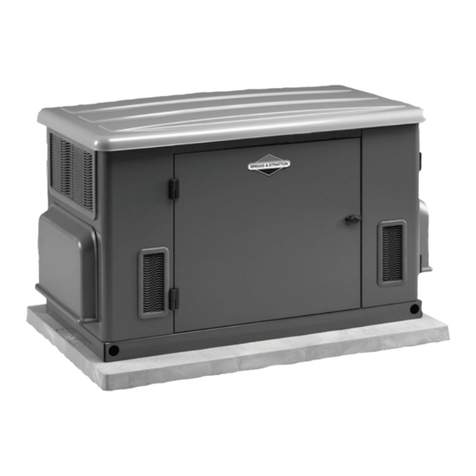
Briggs & Stratton
Briggs & Stratton Home Generator Installation & start-up manual

Milwaukee
Milwaukee L4 PPS manual

EcoInnovation
EcoInnovation PowerSpout TRG 28 installation manual
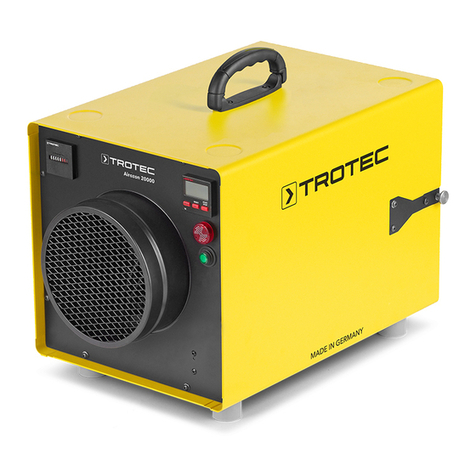
Trotec
Trotec AIRZON 20000 Original instructions
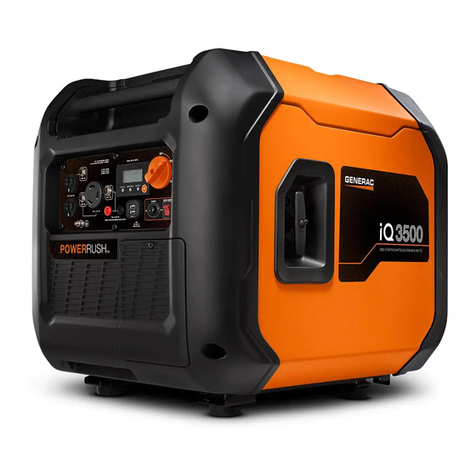
Generac Power Systems
Generac Power Systems iQ3500 owner's manual
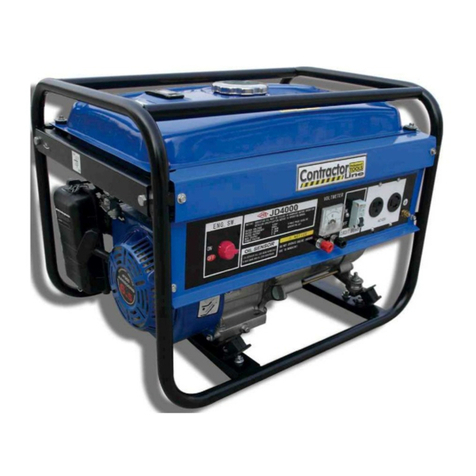
Contractor
Contractor GEN4000/03237 instruction manual
